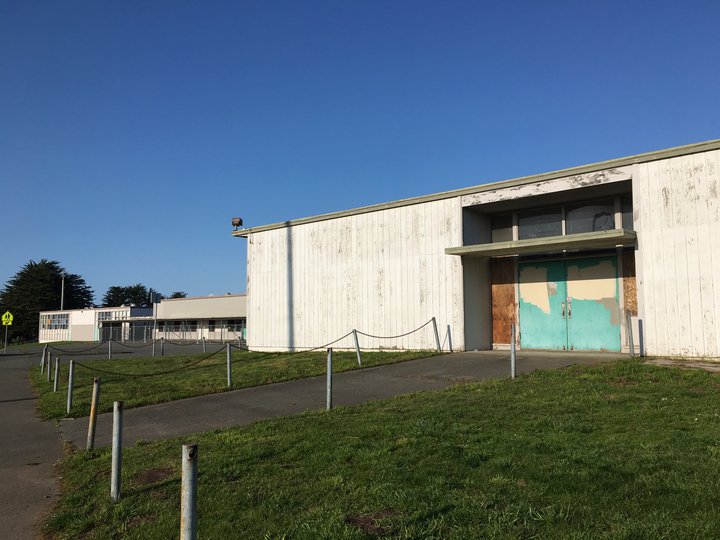
The abandoned Jacobs campus on Utah and Allard, Eureka.
It’s been over a decade since the doors closed at the Jacobs Jr. High School campus, near Highland Park in Eureka. Today the building sits empty with broken and boarded windows, splashed with graffiti, mostly surrounded by a chain-link fence. The building is now seen by many neighbors as a blight on their community. And some of them are getting pretty tired of it.
About six months ago a group of about 15 residents from the the area surrounding the campus formed the South Eureka Neighborhood Alliance (SENA). One of the SENA organizers — former city planner Delo Freitas — told the Outpost that after canvassing and asking neighbors to fill out surveys they learned that many people are worried about the impact the abandoned school is starting to have on the neighborhood.
“It’s fallen into pretty severe disrepair,” Freitas said. “The neighbors really want to see it addressed.” She mentioned that while the building has been empty, homeless people have broken in to sleep in it and several fires have broken out there.
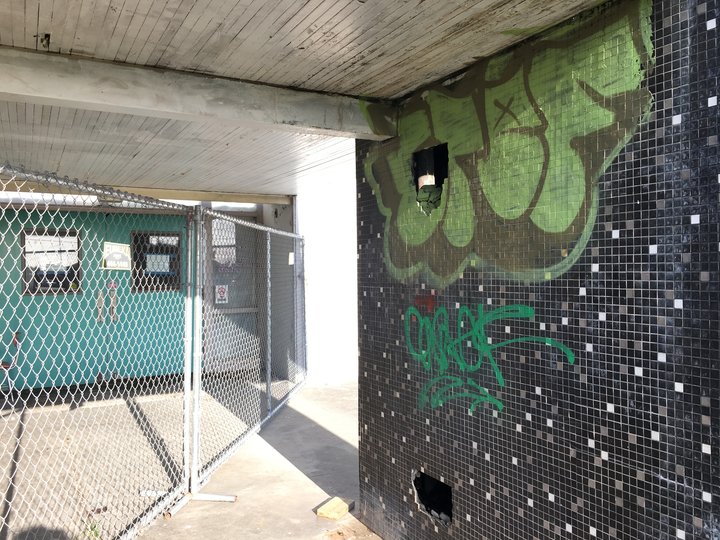
Although Freitas now lives a couple miles away from the campus, she spent the better part of her life in the Highland Park neighborhood. She helped form the alliance mostly as an advocate for her parents who still live near the school, in the house where she grew up. Freitas says a lot of positive changes are happening in the neighborhood in recent years, with more families moving in. People are buying houses and fixing them up. The greatest nuisance to the neighborhood, Freitas says, is the abandoned building on the Jacobs site.
The structure was built in 1956, originally to house the George C. Jacobs Junior High School. The school closed in 1982 due to declining enrollment. It has since served as an adult education center and was home to Zoe Barnum High School until it closed in 2009.
Since the school’s closure the Eureka City Schools Board of Education has been faced with the challenge of what to do with the site. At the next meeting, on April 4, the board will be deciding whether or not to sell the property.
But why has it taken so many years to make a decision? Superintendent of Eureka City Schools Fred Van Vleck told the Outpost that one of the issues has been money.
Site evaluations have determined that because of the condition of the building the only viable option is to demolish it. As the years have gone by the building has become dilapidated. It contains lead paint and asbestos. The cost of the demolition is estimated at $2 million dollars.
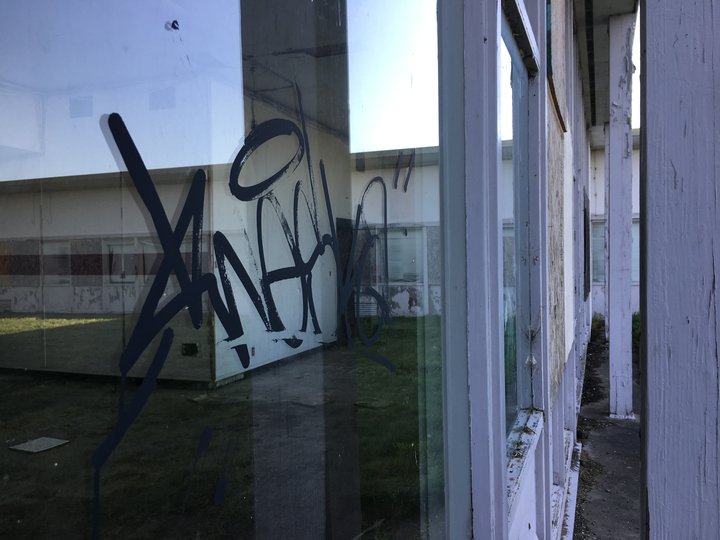
The school board has put some money into this process already. A news release posted on the Eureka City Schools website in February says that last year the board allocated $200,000 to start the demolition process. The money was spent on the abatement of the hazardous materials from some portions of the school buildings.
But overall the board has not been prioritizing putting money into the Jacobs site. Van Vleck told the Outpost that the board has chosen to focus spending their funds on improvement projects for operating schools.
“The board has opted to spend our dollars where the students are now,” Van Vleck said. “One of the things I think is important for community to remember is the school board’s task is to be overseers of education here. [Our] number one priority is what is best for students.”
It seems that since there is no use for the building and a problem with funding, that the board would have opted to sell the property long ago and use the money for demolition. But Van Vleck explained that the board has been apprehensive about selling the property, on the assumption that the district may need it in the future.
If the economy were to improve and the population to grow in Eureka, there may be a need to open another school. If the board were to give up the Jacobs site, Van Vleck explained, it might not have any location options for opening a new school. The Jacobs site is already owned by the school board, is within Eureka city limits, is large enough for a school and out of the tsunami zone. “There’s no other piece of property like it,” Van Vleck said.
But despite the possible benefits of holding on to the site, Van Vleck acknowledges that in the short term the best solution would probably be for the board to sell the property. Especially now, with mounting pressure from neighbors to see the campus cleaned up.
Although the board’s priority is to its students, Van Vleck says he understands the importance of addressing the concerns of the neighbors as well. Out of meetings with SENA and other community members, an idea came up for helping monitor the safety and security of the Jacobs site.
A few weeks ago, the board enlisted the help of New Directions, a non-profit led by John Shelter that offers cleanup services and helps provide opportunities for homeless individuals. A few individuals from New Directions are staying on the Jacobs site, providing 24 hour security and doing cleanups.
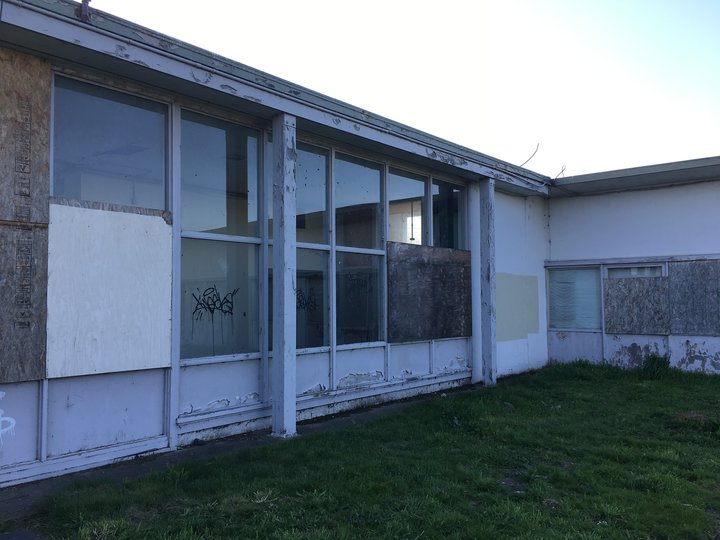
Heidi Benzonelli, the president of Eureka’s Westside Community Improvement Association (WCIA), has been following the progress on the Jacobs campus and helping give a space for SENA to hold its meetings. Benzonelli says that she sees the school board working to make some improvements, like with the placement of New Directions on the site, but she hopes the board will make more effort to respond to the needs of the community.
The WCIA founders went through a similar situation to the SENA neighbors after Jefferson Elementary School closed in their neighborhood in 2005. For years the neighbors watched the 2.5 acres sit unused and the building deteriorate, becoming a blight to their community. The school board was not dealing with it.
“They let the neighbors suffer with the impacts of just not caring about such a huge site,” Benzonelli said.
When the neighbors could take it no longer, they formed WCIA. They saw an opportunity to purchase the property and turn it into something the community could once again be proud of.
The process took years and the group encountered several roadblocks. But eventually they were successful in gaining control of the site. Today the old school is home to the Jefferson Community Center, which holds classes taught by community members, a bike library, a community garden, a playground, child care services and much more.
Benzonelli says it was the unique abilities and organizing powers of West Side neighbors that made this transition possible. She believes that SENA is organizing effectively and can have the same results. It is just a matter of getting the school board to listen.
“When you have a site that big, it’s really your responsibility to listen to the neighbors, be part of the community and work together to see that the needs of community are met as a whole,” Benzonelli said.
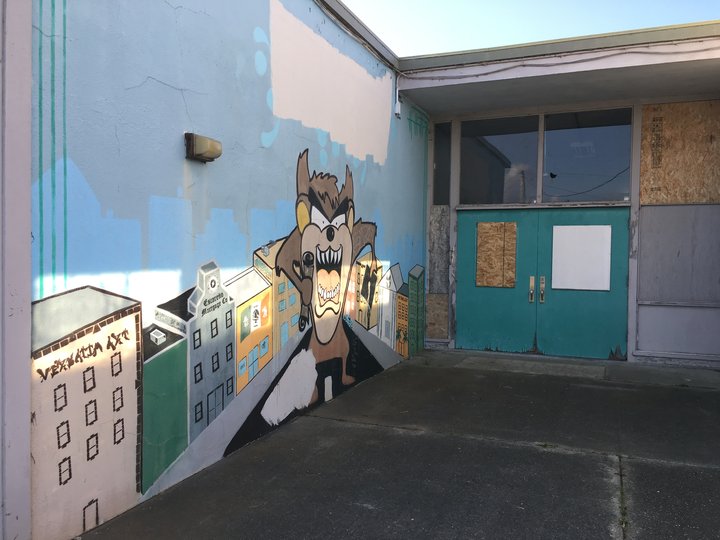
Freitas told the Outpost that, although the accomplishments WCIA made with the Jefferson Center are truly inspirational, SENA does not expect to achieve the same things with the Jacobs site. Because the old school building is slated for demolition, it would be much more difficult to build something like a community center.
Freitas would love to see the property be used for some kind of community space. But she says that anything would be an improvement from what it is now. Though Freitas appreciates the efforts the board has made so far, she would like to see them prioritize the Jacobs site and the surrounding neighborhood.
At the very least, Freitas feels it is time to see the deteriorating building demolished, which has been there for far too long.
“We don’t think it is fair that this neighborhood has to bear the brunt of this blight,” she said.
For all those interested in the future of the Jacobs campus, SENA is holding a town meeting on Saturday, March 30 at 10 a.m. at the Jefferson Community Center (1000 B Street, Eureka.)
The Eureka City Schools Board of Education will meet on Thursday, April 4 at 6:30 p.m. at the Eureka City Schools District Office (2100 J Street.)
You can view the agenda here.
CLICK TO MANAGE